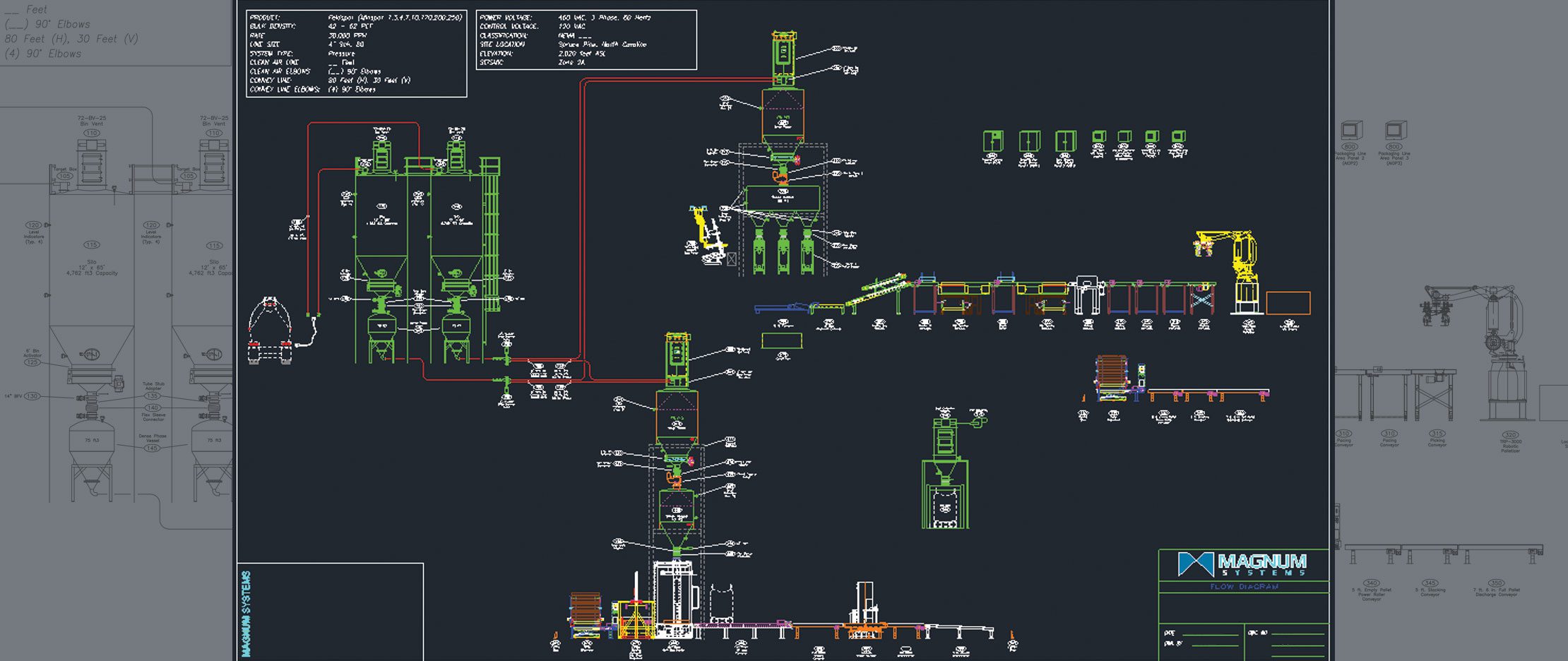
Pneumatic conveying systems are vital in many industrial processes and crucial for efficiently transporting bulk materials. However, limiting product breakage in pneumatic conveying systems is one of the most common challenges. Fortunately, there are strategies for minimizing breakage and enhancing the efficiency and effectiveness of your conveying system. Magnum Systems’ regional sales manager, Max Griffiths, offers five critical solutions to help reduce this issue.
Limit Conveying Distances and Elbows
Limiting breakage in pneumatic conveying systems is mainly driven by the relationship between velocity (air volume) and pressure. The most direct solution for maintaining a consistent velocity-pressure profile is to keep your conveying routing short and simple, which involves limiting the number of elbows and overall distance in your system.
“As distance and elbows increase, so does your pressure loss, leading to higher conveying velocities,” explains Magnum Systems’ regional sales manager, Max Griffiths. “These higher velocities create more friction between the conveyed material and pipe, causing breakage and attrition of the product.”
Use Specialty Elbows When Applicable
Specialty elbows that limit the material conveyance along the backside of the bend can further prevent product attrition. These components are designed to create a pillow of material in the precisely engineered pocket of the elbow and gently redirect the product flow, minimizing impact and friction, which cause everyday wear and tear in traditional elbows.
Optimal Routing and Distance Considerations
Keep conveying routes horizontal and vertical, without any 45-degree inclines. Steep inclines can significantly increase the stress on the system and the products being conveyed. Maintaining routes that are either horizontal or vertical minimizes the gravitational impact on the product and reduces the chances of product slip-back or breakage, ensuring smoother operations.
Selecting a pick-up point and destination nearby is always preferred. However, if your plant layout doesn’t allow this, several approaches exist to maintain optimal velocities. One such approach is to “step” the pipe size as distance increases. Increasing the pipe size down the convey line expands the air inside the pipe, resulting in lower velocities and gentler product handling. This is typically done near the material’s destination (storage silo, surge hopper, weigh bin), where velocities are the highest.
Testing for Material Characteristics and Conveying Conditions
Another way to minimize wear and tear is to use conveying test labs to imitate real-time conditions and optimize conveying parameters. Testing your conveying system in a controlled environment can provide valuable insights into how the system will perform under real-world conditions.
“The best way to optimize these conveying conditions is through material testing in our state-of-the-art conveying lab,” says Griffiths. “Here, we can imitate in-field conditions and make our recommendations for pick-up velocity, pressures and pipe size for the most appropriate conveying parameters.”
By testing your material in a sophisticated test lab, like Magnum’s new lab in Lenexa, you will better understand your material’s characteristics, such as size, shape and bulk density, further helping to limit product breakage.
Dilute-Phase vs. Dense-Phase Conveying
Selecting the mode of transfer of the product is extremely important. Should you convey under positive or negative pressure? Dilute-phase or dense-phase conveying? These considerations tie back into conveying distance, routing and material properties. If the distance is far, vacuum conveying is likely ruled out due to limitations on pressure.
“Longer distances require higher pressures that a vacuum system cannot generate,” Griffiths points out. “You may be pulling material through the line at higher velocities, leading to more breakage and, eventually, a plugged line.”
Dense-phase conveying, commonly referred to as slow-motion conveying, is often the preferred method for limiting material breakage. It is characterized by high pressures and low velocities, leading to minimal wear and product attrition.
Pneumatic conveying systems are custom-engineered to meet each customer’s particular product and process. The parameters and properties we covered in this blog must be considered when designing these systems. Without careful consideration, dissatisfaction with the performance and overall end product is bound to happen. Using these expert guidelines can significantly reduce product breakage and enhance the efficiency of your pneumatic conveying system. Magnum is here to help. Please get in touch with us to test your product and significantly increase your line’s production and efficiency with a custom conveying system.
Magnum Systems podcast series, AIM!
RELATED POSTS
What is a Pneumatic Conveying System?
Troubleshooting Pneumatic Conveying Systems – Dilute & Dense Phase
Magnum Systems Highlights Seven Benefits of Dilute-Phase Pneumatic Conveying
What Are the Advantages of Dense-Phase Pneumatic Conveying?
Magnum Systems’ Pneumatic Conveying: Small Systems, Big Impact
Five Reasons to Partner with a Material Handling Systems Integrator
Related Post
Custom Systems Integration: Why One-Size-Fits-All Solutions Fail
Five Ways to Expand Automation Through Controls Migration Without Sacrificing Employee Morale
Predictive Maintenance Part Three: Predicting the Future of Industrial Systems